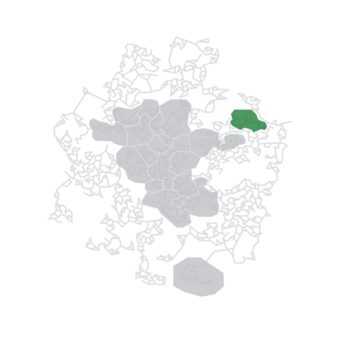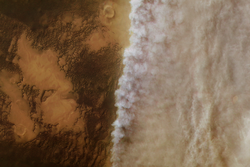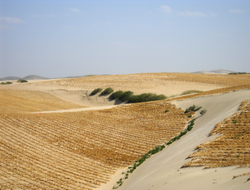Holy Tal'Akdar
State of Holy Tal'Akdar | |
|---|---|
|
Flag | |
 Location of Tal'Akdari space within the galaxy (in green) | |
| Capital and largest world | Tal'Akdar, Tsryn-Dal |
| Official languages | Tal'Akdari |
| Ethnic groups | 90.13% Tal'Akdari 4.51% Nintan 2.04% Ungar 1.97% Tasreen 1.30% Sansu 0.05% Tai Shar. |
| Religion | Tintanar |
| Demonym(s) | Tal'Akdari |
| Government | absolute martial theocracy |
| Saryr II | |
| Taryn Akdar-Turim Bestanar | |
| Grekar Camala Razhad | |
| Legislature | Council of The Righteous |
| Unification under the Tal-Turim | |
| -300 PA | |
| -240 PA | |
| -130 PA | |
• Ascension to the Assembly | 41 PA |
| Population | |
• 84 PA census | 87,565,980,937 |
| Date format | yyyy/mm/dd (PJM) |
The State of Holy Tal'Akdar (Tal'Akdari: ![]() ; tr. Dōs Tsār Tal'Akdār), also known as Tal'Akdar, is an absolute martial theocracy located in the galactic east of Núlne. Tal'Akdar is one of the largest states, spanning 22 solar systems and has a total population of 87.65 billion. Tal'Akdar in the Tsryn-Dal System acts as capital.
; tr. Dōs Tsār Tal'Akdār), also known as Tal'Akdar, is an absolute martial theocracy located in the galactic east of Núlne. Tal'Akdar is one of the largest states, spanning 22 solar systems and has a total population of 87.65 billion. Tal'Akdar in the Tsryn-Dal System acts as capital.
The modern Tal'Akdari state was formed in -300 PA with the discovery of a colossal crashed alien vessel in the Sandazan Depression on Tal'Akdar, by a group of archeologists contracted by the Tal'Akdari religious authorities to search for religious artifacts. The crashed vessel was found to be in good enough condition for rapid reverse-engineering, which the Tal'Akdari religious authorities used to secure global unification under a theocratic regime.
In wake of global unification and the reverse engineering of the crashed vessel, the Tal'Akdari experience a dramatic advancement in technology, culture, sociology and the economy. Within a decade of the Joyous Miracle, the chronic shortages of food, declining resources and over-population were solved either through domestic technological innovations or through the successful colonisation of Tal'Akdar's two moons of Sar and Akdar-Turim. By -250 PA, the Tal'Akdari had expanded across the entire solar system, which resulted in the discovery of the Windway. In -200 PA, the Tal'Akdari tested their first successful faster-than-light drive utilising the wind way phenomenon, in what is considered to be the climax of the Resplendent Ascendance period.
From -200 PA until the ascendance of the Tal'Akdari state into the Interstellar Assembly, the Tal'Akdari would rapidly expand beyond their home-system, launching multiple colonisation efforts of neighbouring systems, as well as using force to conquer or absorb primitive species, sparking the Age of Blessed Prosperity. However, this period also saw instances of instability, civil strife and colonial agitations. In 39 PA, the Tal'Akdari made first contact with the XX, an Assembly-member race, within two-years the Holy State had become a fully-fledged member of the Interstellar Assembly, unleashing a new wave of trade, cultural opening and diplomacy.
As a near-totalitarian absolute theocracy, Tal'Akdar has an often troubled relationship with the Assembly, though in recent decades its involvement has rapidly grown, parallel to its economy, military strength and technological advancement.
History
Pre-history
Ancient
Classical
High-classical
Early Modern
High Modern
According to Tal'Akdari historiography, the High-Modern period began with the advent of the industrial revolution in the state of Calamdyr in -524 PA. Over the next few decades, industrialisation would spread rapidly across the southern hemisphere of Tal'Akdar. The resulting innovations in technology, medicine, food production and transportation resulted in a population boom that would last up until -321 PA.
The discovery of fossil fuels in -434 dramatically enhanced the level of technological advancement and economic change. Across much of Tal'Akdar, entire societies were transitioning from feudal agrarianism toward capitalistic industrialism, leading to the rise of science and the nascent but steady decline in the power of religion. This discovery of valuable fossil fuels propelled expansionism and colonialism, with Calamdyr and Gereydah utilising their access to the Great Water ocean to spread across continents, while Rezedar, using its immense population, expanded dramatically between -411 PA and -388 PA to dominate the northern hemisphere.
By -365 PA, tensions between the major powers over resources and territory erupted into the trilateral war known as the War of the Three Emperors, the war would see extensive devastation on a global scale, including the use of atomic weapons by Calamdyr against Rezedar. Ultimately, Calamdyr would emerge victorious and become the global superpower. The conflict left over 80 million dead and millions more displaced.
Following reconstruction, Tal'Akdar experienced a lengthy period of peace, stability and prosperity. Technological innovations brought about by the war continued steadily, however, the level of industrialisation, the mass consumption of resources and the post-war population boom laid the foundations of the period known as the Arduous Trial. Between -355 PA and -330 PA, Tal'Akdar's population exploded from 3.4 billion to 8.91 billion.
In -329 PA, a series of political uprisings and revolutions across the southern hemisphere, saw the domination of Calamdyr collapse and the emergence of a multi-polar world. These events would prove devastating in the years to come as renewed global tensions, exacerbated by the effects of the Arduous Trial, only weakened global cooperation in confronting the global crisis to come.
Arduous Trial
The Arduous Trial (-329 to -300 PA) refers to the period of extreme climate change, social and moral decay, economic collapse and water wars that emerged as a result of decades of over-population, dwindling resources and climate change brought about by uncontrolled carbon emissions.
Despite the initial problems of the Arduous Trial emerging in the immediate post-war period, the pace of environmental and bio-diversity decline hastened as the planet consumed greater resources in wake of the war. The period officially began in -329 PA, with the complete disappearance of Lake Dagaren, which provided water for over 300 million people, scientists noted that the lake was drying out and lobbied for restrictions on exploitation. Concerns were dismissed by governments due to the lake’s seasonal-based reductions, however, the summer of -329 PA, saw the lake dry out completely and to this day has yet to return.
The Lake Dagaren crisis caused severe economic and health issues for its basin regions, with the nation of Golomdyr instituting water rationing in -328 PA. Tal’Akdari scientists then warned at a major conference, if global changes were not instituted, the worsening climate would effect all nations and by -310 PA, become irreversible.
In -327 PA, it was widely accepted that the planet had reached peak fossil fuel production and output rapidly began to collapse soon after, sparking economic crises across the planet. While some states had succeeded in reducing fossil fuels through the use of hydroelectricity, the collapse of aquifers due to over-exploitation limited the industry’s capacity.
In -326 PA, the northern hemisphere was struck by the Saran-Jadir (Long Night), with the emergence of a colossal sandstorm, worsened by the erosion of top-soil in the concentrated agricultural regions. The planet’s natural arid nature provided the storm with sufficient particulates and dust, but top-soil erosion and rampant desertification exacerbated the storm’s durability. The storm covered the over 40% of the northern hemisphere for 29 months, devastating agriculture and power grids. The storm directly killed an estimated 4.6 million people, while its lasting effects on agriculture is believed to have killed 22.98 million through starvation and social unrest.
Between -326 PA and -310 PA, numerous sandstorms would break out across both hemispheres, while water sources were vanishing at a growing rate. In -319 PA, the state of Hazaridah, dammed the Gol-Dalanyr river, sparking the Gol-Dalanyr War, between it and the states of Shoraydah and Fereena, the war would escalate into the use of chemical weapons. Peace was negotiated by Calamdyr, with the river re-opened, though the deaths of 29 million people further deepened the growing global malaise.
Further resource and water wars would erupt from -315 onward, while the major powers of Calamdyr, Gareyn and Shuraydar suffered devastating economic declines, alongside social decay and moral decay. Records from the time describe many Calamdyrian cities becoming "cesspools of criminality, debauchery and nihilism." From -312 PA, climate refugees grew exponentially with over 2.64 billion fleeing the encroaching deserts, the chaos and instability led to the Great Awakening, a religious revival and the global domination of the Tintanar faith. The Tal'Turim, the governing church of Tintanar soon described the planet's decline as "heavenly justice for the sin engulfing the world."
In -309 PA, war broke out between Calamdyr and Shoraydah over the last viable deposits of consumable fossil fuels in the southern hemisphere. Between -309 and -302, over 15 million people would be killed in the conflict and use chemical weapons, while the strain of climate refugees brought three states to total collapse. In -301 PA, Calamdyr struck Shoraydah with three atomic weapons, killing over 4 million people. While the atomic attacks crippled Shoraydah's willingness to fight, the collapse of Calamdyr's weakened food supply-chains brought its government to near-collapse. Many commentators noted that the collapse of Calamdyr would effectively signal the planet's demise.
While the Joyous Miracle of -300 PA, would save the Tal'Akdari race, the damage suffered during the Arduous Trial would transform global society on a cultural, socio-political and religious level. As the leading historian of the period, Galan Tandryn Hasir wrote in 1 PA, "in twenty years we came from being a world of selfish beasts, to becoming a world of self-sacrifice for the greater good, we would go without water to water our children and we would starve to fill their bellies. This is the legacy of the Arduous Trial, it built in us the capacity to survive any trial." It is believed that through direct effects, in-direct (such as war, societal and economic collapse), Tal'Akdar's population crashed from 10.11 billion in -325 PA to 7.32 billion.
Joyous Miracle
In -301 PA, despite the global calamities unfolding, the Tal'Turim; the global church, continued to search historic sites for religious artifacts. Some circles with the clerical hierarchy believed that solutions could be found by seeking out objects described of being imbued with immense power in religious texts. The same year the Tal'Turim dispatched a team of respected archeologists to the Sandazan Depression region of Calamdyr.
On 27 Shuramdar -300, the team discovered a large man-made structure deep within the heart of the desert. Upon arrival they determined the structure to be metallic and not stone, and not a natural rocky outcrop. The team established an outpost and began trying to access the vast structure. Upon entry and external study, they determined the structure was a large vessel, within two days, the vessel exhibited signs of power and activity. On 1 Kudandyr, the team accessed what later became known as the 'Holy Shrine of the Miracle', there they discovered the vessel to have crashed on Tal'Akdar 8,000 years ago. The vessel's systems were activated and the team began to interact with what turned out to be an artificial intelligence. This was followed by several months of intense study by Tal'Turim sponsored scientists and engineers. News of the discovery was kept secret, protecting the site from the Calamdyrian government.
In the final month of -300 PA, the Tal'Turim announced its discovery, claiming it had "through divine providence came to find a great bountiful gift from the Gods, the means to save the Tal'Akdari civilisation and restore it to greatness through faith." The announcement coupled by the collapse of the Calamdyrian government provided the Tal'Turim with sufficient popular support to declare itself the only viable "government" for the Tal'Akdari race. Seizing control of Calamdyr's state apparatus, the Tal'Turim focused all of the country's scientific might into reverse engineering technologies and designs provided by the vessel's AI.
Between -299 PA and -295 PA, the Tal'Turim began distributing technologies aimed at agriculture, water purification and climate-alteration to the surviving states across the planet, usually in exchange for capitulation. States that refused were soon attacked by Tal'Turim controlled forces, armed with weapons and systems far outstripping that of its opponents.
Global unification
Following the Joyous Miracle and the successful interaction with the AI, the Tal’Turim moved to expand its control to unite the Tal’Akdari race. Using reversed engineered technologies, it rapidly expanded control beyond Calamdyr; offering vital systems aimed at combatting the effects of the Arduous Trial to governments, in exchange for political subordination. States that refused were attacked by religious forces armed with energy-based weapons. Successive propaganda campaigns presenting the Joyous Miracle as divine intervention led to religious-inspired uprisings and revolutions across Tal’Akdar, with governments being overthrown by cleric-led movements.
By -291 PA, the Tal’Turim had gained control over every nation state and at the Day of the Seven Saints, the Archon of the Faithful, Oberdyr VII proclaimed global unification through the Holy State of Tal’Akdar. Within months of unification, the pace of technological advancement continued unabated while the new global government distributed medical breakthroughs to the most devastated regions of the planet.
Between -290 and -286, the global theocratic regime obliterated the remaining vestiges of pre-unification Tal’Akdar. Secular monuments were demolished, minority faiths were persecuted, while any and all objects related to ideals or systems beside the ruling theocracy were seized and destroyed. Sporadic revolts or uprisings in opposition to the new regime were brutally repressed, while an effective global police state was established, aided by technologies developed from information provided by the artificial intelligence at the site of the Joyous Miracle.
In -285 PA, the Tal’Turim had secured complete control over the planet and the effects of its technological advancement were becoming clearer. Most diseases had been eradicated, agriculture had rebounded with the development of hardy genetically modified foods and the development of fusion-power had erased the need for fossil fuels.
On 1 Faryd -282 PA, the first manned mission to the moon of Sar was launched, this was followed two years later by a manned mission to the moon of Akdar-Turim. Much to the relief and surprise of the authorities, it was discovered that both moons were relatively inhabitable. In -279, the Tal’Turim announced its intention to settle colonists on Tal’Akdar’s two moons.
With the climate stabilising and the food shortages defeated, the Tal’Turim’s announcement unified the race in purpose, with vast resources being pushed into developing the necessary infrastructure to colonise the moons.
Resplendent Ascendance
Age of Blessed Prosperity
Wars of expansion
Present
Astrography
Government and politics
As per the Codex of Governance (the Tal'Akdari constitution), the Holy State is a federal absolute theocracy with power vested in the executive office of the Blessed Archon, who is aided by two subordinates, the Cardinal-Superior and Deacon-Superior, who represent the two "pillars" of government, the Diaconate and Cardinalate.
However, in reality, the Tal'Akdari state is greatly de-centralised with governance operating in a tiered administrative sense. The federal government under the Blessed Archon, only maintains significant control over defence, foreign policy, security, inter-system infrastructure, law enforcement and socio-religious matters. While individual world authorities maintain control over their economies, industry, infrastructure and education.
Since the government operates on absolutist terms, the entire state apparatus runs parallel to that of the Tal'Turim; the religious authority of Tal'Akdar, and the military. Politicians and civil servants are appointed in a top-down form of patronage. As a result, the entire governing system of Tal'Akdar is devoid of any form of popular franchise or democracy.
Blessed Archon
The Blessed Archon of the Faithful, is the supreme political and religious authority in Tal'Akdari space. The Blessed Archon is responsible for delineation and supervision of the policies of the Holy State. The Cardinal-Superior and Deacon-Superior have limited power compared to the Blessed Archon. The current longtime Blessed Archon, Saryn III, has been issuing decrees and making the final decisions on the economy, environment, foreign policy, education, national plannings, and everything else in Tal'Akdari space.
The Blessed Archon is required to sign off all legislation and decisions made by the federal government and has power of veto over all matters presented at the federal level. The Blessed Archon is also tasked with approving the candidates elected for the offices of Cardinal-Superior and Deacon-Superior; who are elected by their respective pillars. The Blessed Archon may dismiss the elected candidate and appoint personally. The Blessed Archon must also approval all members of the Supreme Consistory of Holy State (council of ministers) following their recommendation by both the Cardinal-Superior and Deacon-Superior. The Blessed Archon is also tasked with the appointment of all planetary and quadrant governors, he may also dismiss any office holder at will.
The Blessed Archon is the commander-in-chief of the armed forces, controls the military intelligence and security operations, and has sole power to declare war or peace. The heads of the judiciary, the state virtual and interstellar networks, the commanders of the police and military forces and heads of state science and technology bodies.
The combined session of the Council of the Righteous elects and dismisses (to date, never did) the Blessed Archon on the basis of qualifications and popular esteem. The office is held for life and upon the death of a Blessed Archon, the Council of the Righteous meets and holds a Naryn Jura (Solemn Election) to elect one of their number.
Cardinal-Superior
Deacon-Superior
Council of the Righteous
Assembly of the Blessed Warrior
Council of the Most Devout
Administration
The Holy State is comprised of 22 solar systems, which are divided into 'quadrants', the Holy Core, the Western Quadrant, Southern Quadrant and Eastern Quadrant. Each quadrant is governed by a singular authority based upon the quadrant's most populous and developed world, while each populated world in each quadrant enjoys some autonomy from the Quadrant-Authority. This tiered system has proven highly productive in terms of streamlining development, policy and colonial operations.
Interstellar relations
Military
The armed forces of Holy Tal'Akdar collectively are known as the Holy Forces of Tal'Akdar and are divided into four separate branches, the Holy Planetary Force, the Holy Star Fleet, the Holy Planetfall Force and the Frontier Patrol Corps (for border security).
The Tal'Akdari military is highly centralised, with all branches (except the Frontier Patrol Corps), operating under universal umbrella unit organisations. The largest unit is the Star Order (Chudan'Styr), which is comprised of three Cadres (Tydar), with each cadre being comprised of forces from the Star Fleet, Planetfall Force and Planetary Force. Each cadre may operate independently of the others under the overall command of its corresponding Star Order.
The Planetfall Force is designed to operate in tandem with the Planetary Force, insofar that it constitutes the elite stormtrooper branch, tasked with establishing beachheads on celestial bodies, and then to expand the areas of operation for deployment of regular surface-based forces.
The Holy Star Fleet is built around the Tal'Akdari concept of "Turchang S'Dyr" (Domination of the Dark), in the form of preemptive shock offensives against enemy territory, infrastructure and forces combined with dispersed raiding squadrons, to target economic systems, commercial shipping and isolated military facilities. Once hostile space (or a planetary system) is engulfed with forces, coordinated planetary offensives would be launched. With spacial dominance achieved, larger and more populous worlds will be blockaded, as smaller worlds and celestial bodies are seized. As a result, the Star Fleet is comprised of vessels geared toward ship-to-ship combat, offensive deployments, but also smaller vessels that use speed and heavy weaponry to overwhelm and ostensibly raid enemy territory for long periods of time.
The most prominent branch remains the Holy Star Fleet, which has since 83 PA, been granted oversight and control of Tal'Akdar's colonial expeditions. The highly militaristic nature of the Tal'Akdari government and society has enabled its military to grow at a pace and size far exceeding the state's relative size. Some Embassy Races consider the Tal'Akdari military to be one of the most prominent within Assembly Space, utilising advance technology, well-designed and supplied vessels and a well-disciplined, battle hardened fighting force.



